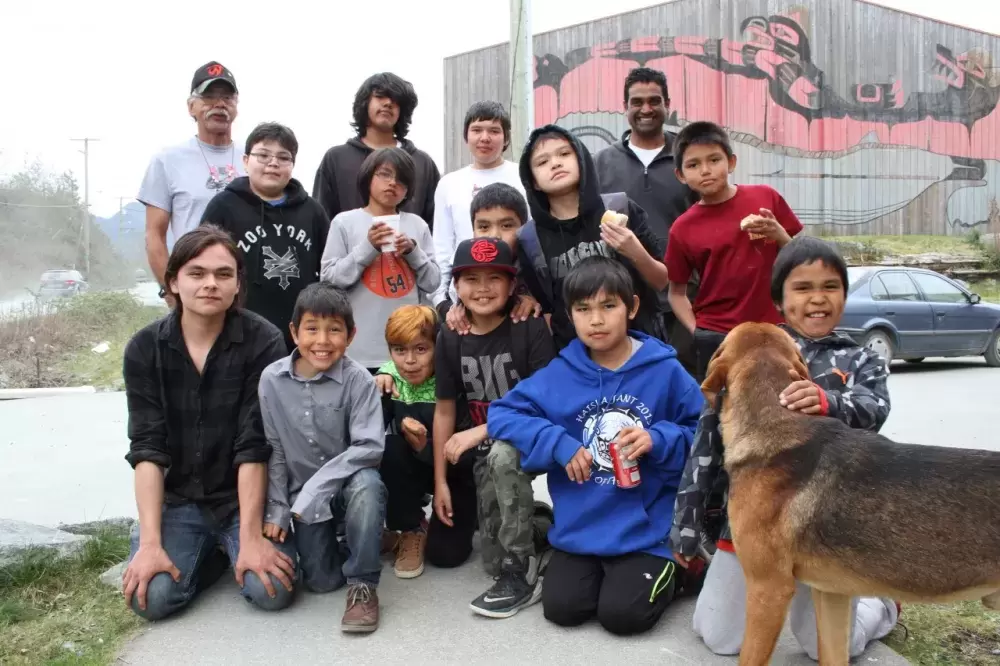With more than half of its on-reserve population under the age of 25, the future of Ahousaht belongs to the young.
And nearly 500 people in the Flores Island community of about 1,100 are under 15, according to a report from the First Nation that was sent to the B.C. Joint Standing Committee On Rural Issues in 2017, which said that 30-40 babies are born in Ahousaht each year.
Beyond the reserve the Ahousaht First Nation has also rapidly grown in membership over the last decade, increasing from less than 1,900 to almost 2,200, according to Nuu-chah-nulth Tribal Council records.
But who tomorrow’s men will be and how they’ll protect and provide for the community has become a foremost concern for a small group behind a new leadership program for the First Nation’s boys. The Ahousaht Way Warrior Program launched in September 2018, meeting four and a half hours once a week to foster an active environment of brotherhood and mentorship through cultural activities and the teaching of outdoor skills. Twenty boys are regularly involved, mostly ranging from eight to 14 years old.
On April 2 those involved with the group met at Maaqtusiis Secondary School to speak about their progress and reach out for more support. Tom Paul said the program aims to break the cycle of addiction that has affected multiple generations in Ahousaht, which remains a by-product of the last 150 years of colonization under the Government of Canada.
“We wanted the community to see what we’re doing together,” said Paul. “The brotherhood, respecting each other and working together - every time we get together that’s what I talk about.”
The Ahousaht Warriors have also camped once a month by the Megin River, which is north of the community. With its Sitka spruce and western red cedar forest, this remote location has been a provincial ecological reserve since 1981. The river supports spawning runs for sockeye, chinook, coho, pink and chum salmon, but BC Parks notes that “lack of knowledge of natural and cultural values makes protection difficult.”
“I picked Megin for a reason,” said Paul. “Firstly, it’s an untouched watershed; secondly, it’s the only sockeye-bearing stream left in our territory, and it’s at risk.”
During the Warriors’ first trek to Megin they found someone had been illegally fishing from the river.
“There was a net there the first weekend we went,” said Paul. “That’s when we had that first discussion about protecting that river.”
The Ahousaht program is a new chapter in what began four years ago with the Hitacu Warriors from the Yuułuʔiłʔatḥ First Nation. The Tla-o-qui-aht also has a Warriors program.
Daniel Williams has been in the program for three years after he was introduced to the Hitacu Warriors at a potlatch. He said the program provides a “consistent safe space” for all of the boys involved.
“We’re not going to judge them in any way, we’re not going to get mad at them for doing things, we’re there to teach them, we’re there to show them the right way of doing things,” said Williams during his visit to Ahousaht April 2. “In some people’s lives they don’t always have the safest home or the nicest home or the best parents. The parents might be there, but they might not be there for the child.”
Hayden Seitcher, a 17-year-old who lives in the Tla-o-qui-aht community of Esowista, described how the program has affected him over the last year.
“It’s given me a new confidence,” he said. “You know where you are in your life, you know where you are in other peoples’ lives. It’s a different confidence than what I had years ago.”
As he addressed a group at the high school Seitcher noted that before entering the program his life lacked expectations to accomplish anything.
“I was very disappointed where I was at the time, because I wasn’t doing anything,” he said. “I wasn’t really culturally involved. Having that brotherhood really helps me move to fit into the community, to fit in with my friends and to expect more of myself than just being home alone doing nothing.”
Ha’wilth Nathan Charlie has seen changes since the program came to Ahousaht in September. This is his third year in the community after moving with his family from Victoria.
“There was a couple of the boys, when we first moved here I was walking and these boys were throwing rocks at windows,” said Charlie. “Now they’re just here with other boys and it’s a real change. They have something to do, they’re occupied.”
It’s important that the youth are learning how to be respectful of elders and visitors, he added.
“That’s Ahousaht ways; you feed visitors first,” said Charlie, stressing the value of outdoor skills taught in the program. “Some of the boys just have mothers, they don’t have a father…Showing them stuff like that is, to me, really essential.”
For its leadership training value, Warriors can earn high school credits, starting in September.
This is the first time Maaqtusiis Principal Kate Drexler has seen such a supportive program for boys.
“The checking on each other and concern for one another, it’s hard to teach that in the classroom,” she said.
“I believe culture is healing, culture is identity, culture is connection,” she added. “I think this program provides that way back to culture…it’s reconnecting kids with the land, with the territory.”







